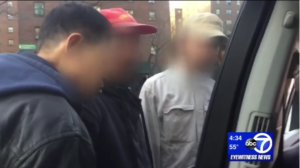 Much has been made about Asian American success, with articles pointing to average and median Asian American income being greater than whites, Asian cultural advantages, and incorrect exaggerations about the percentage of Asian American CEOs in Silicon Valley. Much less is made of that fact that Asian Americans have a wider (and widening) gap between rich and poor than whites. I am came across three stories that when taken together strongly reflect the gap that exists between Asian American rich and poor. The first is the piece above on Asian American day laborers in New York. The second covers a guest lecture by the author of a book called “The Other One Percent: Indians in America” that discusses how Indian Americans are a population unlike any including those in in India, produced by a self-selection process largely responsible for Indian American success. The third is about the flooding in San Jose that financially devastated many Vietnamese Americans living in the heart of a very wealthy Silicon Valley.
Much has been made about Asian American success, with articles pointing to average and median Asian American income being greater than whites, Asian cultural advantages, and incorrect exaggerations about the percentage of Asian American CEOs in Silicon Valley. Much less is made of that fact that Asian Americans have a wider (and widening) gap between rich and poor than whites. I am came across three stories that when taken together strongly reflect the gap that exists between Asian American rich and poor. The first is the piece above on Asian American day laborers in New York. The second covers a guest lecture by the author of a book called “The Other One Percent: Indians in America” that discusses how Indian Americans are a population unlike any including those in in India, produced by a self-selection process largely responsible for Indian American success. The third is about the flooding in San Jose that financially devastated many Vietnamese Americans living in the heart of a very wealthy Silicon Valley.
For those who may not be familiar with what a day laborer is, day laborers are workers who gather in areas looking for work for the day. Employers drive by and work out jobs just for the day. I often see day laborers near the Home Depot I drive by going to work. The ones I see here in Silicon Valley are Hispanic, and I have never seen an Asian American day laborer there. I was surprised to hear about Asian American day laborers in New York, but then again, after writing about Asian Americans riding a bus for hours a day to make their rent, I really should not have been.
There are a number of very prominent Indian American CEOs such as Indra Nooyi of Pepsi, Sundar Pichai of Alphabet (Google’s holding company), and Satya Nadella of Microsoft. Devesh Kapur, an author of The Other One Percent: Indians in America, talked about the self-selection process that made this possible in a lecture at Columbia University. He argued the Indian Americans never went through “the ghetto phase” as other did Asian immigrant groups, as many went through a selection process of being trained professionals, fluent in English, and leaving voluntarily. While that is true for many Indian immigrants, it’s worth mentioning that the early 20th century saw a wave of Indian immigrants that worked in farming or on the railroads that formed communities in the agricultural Yuba City or the Mexican-Punjabi ones mentioned here. Still, despite that history and the fact that there are many Indian immigrants working not so lucrative jobs running newsstands and taxi drivers, there are enough prosperous Indian Americans to move aggregate statistics and the perception of wealth to make them targets of crime.
I was one the East Coast when the flooding in San Jose in February occurred. Looking at a map of the flooded areas, it struck me that the water was really close to the Little Saigon area. As this story points out, many in the local Vietnamese community were badly impacted, especially since there was no warning that Coyote Creek was rising dangerously. Of the 400 families that were still displaced as of March 7, 80% were Vietnamese. Billionaire Kieu Hoang saw the flooding and donated $5 million to flood relief. “This is the time you have to payback,” he is quoted as saying.
We have written about the subject of impoverished Asian subgroups, and others have analyzed the data on Asian American incomes. Aggregate statistics like median and average, when applied to incomes, can hide income disparity. The last two stories, taken together, hit home for me as a San Jose resident in illustrating a massive income divide. The displaced Vietnamese families are going to have a challenging time finding affordable housing in Silicon Valley, where wealthy Asian Americans, many from India, own some of the most expensive real estate in the United States. It’s telling that Asian American billionaire made a massive donation for relief. I don’t know whether the income gap between rich and poor Asian Americans will continue to widen, but these stories show that there are rich Asians Americans and poor Asian Americans, and that the gulf between is very wide.








